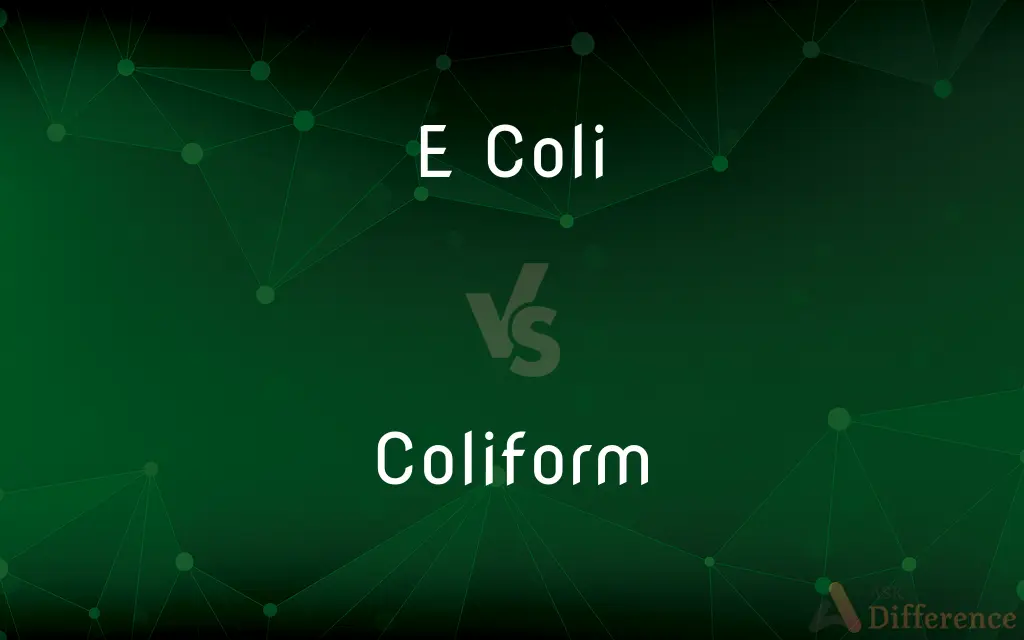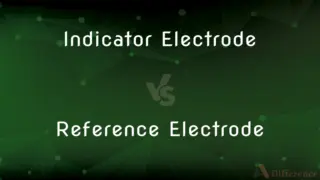E Coli vs. Coliform — What's the Difference?
Edited by Tayyaba Rehman — By Fiza Rafique — Published on December 5, 2023
E. Coli vs. Coliform: E. Coli is a specific type of bacteria within the Coliform group, while Coliforms are a broad category of bacteria commonly found in the environment.

Difference Between E Coli and Coliform
Table of Contents
ADVERTISEMENT
Key Differences
E. Coli is a particular species of bacteria, scientifically known as Escherichia coli, that resides in the intestines of warm-blooded animals. On the other hand, Coliform is a broader term representing a large group of bacteria, many of which are found in nature and not harmful.
Often, when water quality is assessed, the presence of Coliform bacteria is checked as they indicate possible contamination. However, the presence of E. Coli, a subset of Coliforms, specifically suggests fecal contamination.
While many strains of E. Coli are harmless and part of the gut flora, some can cause diseases in humans. In contrast, many Coliform bacteria are non-pathogenic, but their presence can indicate other harmful microbes in water or food.
It's essential to understand that while all E. Coli are Coliforms, not all Coliform bacteria are E. Coli. This distinction is crucial, especially in environmental testing, to determine the potential risk associated with contamination.
E. Coli is often used as a model organism in laboratory research because of its well-understood genetics and ease of growth. Coliform, on the broader spectrum, is typically discussed in contexts related to environmental contamination and sanitation.
ADVERTISEMENT
Comparison Chart
Definition
A specific bacteria species
A broad group of bacteria
Indication
Suggests fecal contamination
Indicates potential environmental contamination
Pathogenicity
Some strains can cause disease
Generally non-pathogenic, but indicate other threats
Relationship
Subset of Coliforms
Broad category, includes E. Coli
Common Use
Model organism in labs
Environmental testing for water and food safety
Compare with Definitions
E Coli
Can be pathogenic causing diseases.
Certain strains of E. Coli can lead to severe food poisoning.
Coliform
A group of gram-negative, rod-shaped bacteria.
Coliform levels are checked to assess water purity.
E Coli
A type of Coliform bacteria.
While testing water, the presence of E. Coli indicates fecal contamination.
Coliform
Mostly non-pathogenic bacteria.
The presence of Coliform doesn't always indicate a health risk.
E Coli
Known scientifically as Escherichia coli.
The lab frequently studies E. Coli for its well-defined genetics.
Coliform
Used as an indicator organism for sanitary quality.
Elevated Coliform levels in a lake prompted a swimming ban.
E Coli
Used widely in biotechnology and research.
E. Coli is utilized for producing synthetic insulin in labs.
Coliform
Commonly found in the environment.
High Coliform counts in water might suggest contamination.
E Coli
A species of bacteria found in the intestines.
E. Coli infections can sometimes result from contaminated food.
Coliform
Includes various bacterial species, including E. Coli.
E. Coli is a specific type of Coliform bacteria.
Coliform
Of or relating to various gram-negative rod-shaped bacteria that ferment lactose, especially those such as E. coli that commonly inhabit the intestines of humans and other vertebrates.
Coliform
Of or pertaining to the bacteria that inhabit the intestines (especially the colon) of mammals
Coliform
Such a bacterium
Common Curiosities
Why is the presence of Coliform in water concerning?
It indicates potential contamination and the possible presence of harmful pathogens.
What does the term Coliform encompass?
Coliform refers to a broad group of bacteria, many of which are found naturally in the environment.
Are all E. Coli considered Coliforms?
Yes, all E. Coli are Coliforms, but not all Coliforms are E. Coli.
What is the significance of Coliform testing in water samples?
It assesses the sanitary quality and indicates potential contamination risks.
Is E. Coli only found in humans?
No, E. Coli is found in the intestines of various warm-blooded animals.
How can one prevent E. Coli infections?
By practicing good hygiene, cooking food thoroughly, and avoiding raw or contaminated water.
How are Coliform bacteria identified in labs?
Through specific culture methods and tests that detect their ability to ferment lactose.
How can one get infected with pathogenic E. Coli?
Through consumption of contaminated food, water, or contact with infected individuals.
What illnesses can pathogenic E. Coli cause?
They can lead to food poisoning, urinary tract infections, and other illnesses.
What is E. Coli?
E. Coli is a species of bacteria found in the intestines of warm-blooded animals.
Can E. Coli cause diseases?
Yes, while many E. Coli strains are harmless, some can lead to diseases in humans.
Are all Coliform bacteria harmful?
No, many Coliform bacteria are non-pathogenic but indicate possible contamination.
Are Coliforms always associated with fecal contamination?
No, while they can indicate fecal contamination, they are also naturally present in the environment.
Why is E. Coli used in research?
Its genetics are well-understood, and it's easy to grow, making it a model organism.
Can E. Coli infections be treated?
Yes, most infections are self-limiting, but severe cases might require antibiotics.
Share Your Discovery

Previous Comparison
Indicator Electrode vs. Reference Electrode
Next Comparison
VTSMX vs. VTSAXAuthor Spotlight
Written by
Fiza RafiqueFiza Rafique is a skilled content writer at AskDifference.com, where she meticulously refines and enhances written pieces. Drawing from her vast editorial expertise, Fiza ensures clarity, accuracy, and precision in every article. Passionate about language, she continually seeks to elevate the quality of content for readers worldwide.
Edited by
Tayyaba RehmanTayyaba Rehman is a distinguished writer, currently serving as a primary contributor to askdifference.com. As a researcher in semantics and etymology, Tayyaba's passion for the complexity of languages and their distinctions has found a perfect home on the platform. Tayyaba delves into the intricacies of language, distinguishing between commonly confused words and phrases, thereby providing clarity for readers worldwide.











































